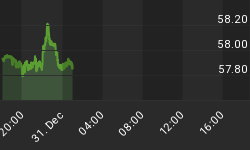The good news is the market, by nearly every intermediate term technical measure, is in good shape.
- Both the NYSE and NASDAQ AD lines made new cycle highs last week.
The implication of new AD line highs is there should be at least one more new high in the blue chip indices in the next 2-6 weeks.
- There have been virtually no new lows on either the NYSE or NASDAQ.
No serious decline has ever began without, at least a modest buildup of new lows prior to the beginning of the decline. A long standing rule of thumb is: There is little reason to worry until you see several days with 40 or more new lows on the NYSE.
- The 10% trend (19 day EMA) of NYSE new highs is at an all time high.
About 15 years ago I did some research on the importance of the 10% trend of NYSE new highs and found that the indicator, on average, peaked at about 55% of the total advance of a 4 year cycle..
The previous all time peak was in July of 97 and is shown in the chart below.
If you identify the bottoms of these cycles as occurring in 1990, 1994, 1998 and 2002 the current cycle has plenty of time left.
I have made no adjustment for total issues traded so it is not surprising that the highest highs have occurred relatively recently. Still, no matter how you cut it, an all time high cannot be bad.

There are many timing programs with a no sell filter based on the 10% trend of NYSE new highs. The cutoff for the filters is usually around 100 or slightly higher. That is no selling is allowed if the 10% trend of NYSE new highs is greater than 100. The current value of the 10% trend of NYSE new highs is 382.
The intermediate term outlook is rosy, but, what about next week?
The market has not taken time off since the November low and is overbought by any short term definition. The chart below shows a trend line drawn across the S&P 500 tops since mid July. The index is well above its trendline. Since the November 20 low, the SPX has risen at an annualized 87% rate.

The table below shows, for the past 15 years, the SPX has had a slight downward bias during the first 6 trading days of the year. The record during the fourth year of the presidential cycle (marked with arrows) has been a little worse.
First 6 days of January.
The number following the % change represents the day of the week 1=Monday, 5=Friday etc.
The number following the year is the year of the presidential cycle.
| SPX | Day1 | Day2 | Day3 | Day4 | Day5 | Day6 | Totals |
| 1989-1 | -0.87% 2 | 1.50% 3 | 0.21% 4 | 0.24% 5 | 0.11% 1 | -0.21% 2 | 0.97% |
| 1990-2 | 1.78% 2 | -0.26% 3 | -0.86% 4 | -0.98% 5 | 0.45% 1 | -1.18% 2 | -1.04% |
| 1991-3 | -1.14% 3 | -1.39% 4 | -0.28% 5 | -1.73% 1 | -0.17% 2 | -1.08% 3 | -5.80% |
| 1992-4 | 0.04% 4 | 0.50% 5 | -0.33% 1 | -0.13% 2 | 0.17% 3 | -0.12% 4 | 0.13% |
| 1993-1 | -0.08% 1 | -0.24% 2 | 0.04% 3 | -0.87% 4 | -0.39% 5 | 0.44% 1 | -1.09% |
| 1994-2 | -0.22% 1 | 0.31% 2 | 0.14% 3 | -0.09% 4 | 0.60% 5 | 1.14% 1 | 1.88% |
| 1995-3 | -0.03% 2 | 0.35% 3 | -0.08% 4 | 0.07% 5 | 0.03% 1 | 0.18% 2 | 0.52% |
| 1996-4 | 0.78% 2 | 0.10% 3 | -0.58% 4 | -0.16% 5 | 0.28% 1 | -1.46% 2 | -1.04% |
| 1997-1 | -0.50% 4 | 1.50% 5 | -0.05% 1 | 0.75% 2 | -0.64% 3 | 0.86% 4 | 1.91% |
| 1998-2 | 0.48% 5 | 0.21% 1 | -1.07% 2 | -0.27% 3 | -0.82% 4 | -2.97% 5 | -4.45% |
| 1999-3 | -0.09% 1 | 1.36% 2 | 2.21% 3 | -0.21% 4 | 0.42% 5 | -0.88% 1 | 2.82% |
| 2000-4 | -0.95% 1 | -3.83% 2 | 0.19% 3 | 0.10% 4 | 2.71% 5 | 1.12% 1 | -0.67% |
| 2001-1 | -2.80% 2 | 5.01% 3 | -1.06% 4 | -2.62% 5 | -0.19% 1 | 0.38% 2 | -1.28% |
| 2002-2 | 0.57% 3 | 0.92% 4 | 0.62% 5 | -0.65% 1 | -0.36% 2 | -0.48% 3 | 0.62% |
| 2003-3 | 3.32% 4 | -0.05% 5 | 2.25% 1 | -0.65% 2 | -1.41% 3 | 1.94% 4 | 5.40% |
| 2004-4 | -0.31% 5 | 0.00% 0 | 0.00% 0 | 0.00% 0 | 0.00% 0 | 0.00% 0 | -0.31% |
| Averages | 0.00% | 0.40% | 0.09% | -0.48% | 0.05% | -0.15% | -0.09% |
| % Winners | 38% | 67% | 47% | 27% | 53% | 47% |
Because of the extremely over bought condition of the market, I expect the major indices will be lower at the close Friday January 9 than they were at the close Friday January 2.
















